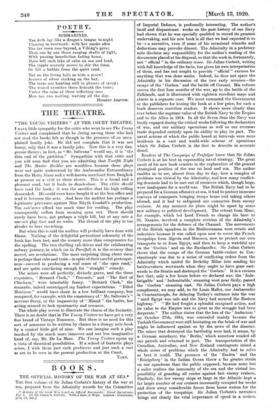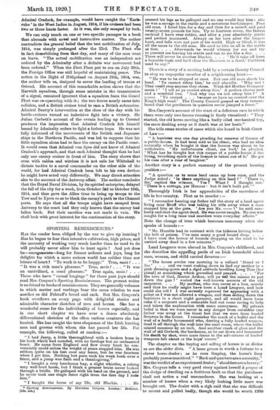BOOKS.
THE OFFICIAL HISTORY OF THE WAR AT SEA.*
THE first volume of Sir Julian Corbett's history of the war at sea, prepared from the Admiralty records for the Committee • HistoryoIthe Great War Eased on Official Documents: Naval Operations, rol. D. By Slr Julian S. Corbett. with a Case of Maps. London: Longman. 117% 01. net.] of Imperial Defence, is profoundly interesting. The author's lucid and dispassionat - works on the past history of our Navy had shown that he was specially qualified to record its greatest undertaking, and his new book is all that we had expected' it to be : s a narrative, even if some of his occasional remarks and deductions may provoke dissent. The Admiralty in a prefatory note disclaim any responsibility for the author's reading of the documents placed at his disposal, so that the work is, fortunately, not " official " in the ordinary sense. Sir Julian Corbett, writing with full knowledge of the facts, has given his own interpretation of them, and has not sought to provide " official " excuses for anything that was done amiss. Indeed, he does not spare the Admiralty in his discussion of the two early reverses—the escape of the Goeben ' and the battle off Coronel. His volume covers the first four months of the war, tip to the battle of the Falklands, and is illustrated with eighteen excellent maps and charts in a separate case. We must commend the Government or the publishers for issuing the book at a low price, for such a book deserves countless readers. It shows more clearly than ever before the supreme value of the British Navy to the Empire and to the Allies in 1914. In all the Seven Seas the Navy was busily engaged during the critical weeks following the declaration of war, and our military operations as well as our overseas trade depended entirely upon its ability to play its part. The naval actions of which the public heard at intervals were mere incidents in a vast and world-wide scheme of operations which Sir Julian Corbett is the first to describe in accurate detail.
Readers of The Campaign of Trafalgar know that Sir Julian Corbett is at his best in expounding naval strategy. The great merit of his new book consists in the explanation of the general strategical position of the war on land and sea. The author enables us to see, almost from day to day, how a complex of problems was viewed by the Admiralty, and how many conflict- ing demands had to be met out of resources which, though large, were inadequate for a world-war. The British Navy had to be prepared for a German offensive at sea, it had to protect immense convoys of transports bringing troops home and taking others abroad, and it had to safeguard our commerce from enemy cruisers. At any moment its plans might be upset by some new military or political development. The retreat from Mons, for example, which led Lord French to change his base to St. Nazaire, involved a complete revision of the Admiralty's arrangements for the defence of the Channel. The movements of the British squadron in the Mediterranean were erratic and indecisive because it was called upon now to cover the French troopships from Algeria and Morocco, now to protect our own transports to or from Egypt, and then to keep a watchful eye on the Goeben ' and on the Dardanelles. Sir Julian Corbett shows that the escape of the German battle-cruiser to Con- stantinople was due to a series of conflicting orders from the Admiralty which misled Sir Berkeley Milne into sending his battle-cruisers westwards when they ought to have gone east- wards to the Straits and destroyed the Goeben.' It is a curious fact that, only a few hours before NVO declared war, the Inde- fatigable' and ' Indomitable,' steaming west near Sicily, passed the Goeben ' steaming east. Sir Julian Corbett pays a high compliment, we may add, to Sir Louis Mallet, our Ambassador in Constantinople, for delaying Turkey's entrance into the war " until Egypt was safe and the Navy had secured the Eastern highway." " He had fought a splendid rearguard action, and its value to the Empire was as great as the struggle had been desperate." The author states that the loss of the Audacious ' on October 27th, 1914, was concealed mainly because the Turkish Government were still hesitating on the brink of war and might be influenced against us by the news of the disaster. The mines that destroyed the battleship were laid, it seems, by a German minelayer, the Berlin,' which somehow evaded all our patrols and returned to port. The transportation of the Canadian, Australian, and New Zealand contingents raised a whole series of problems which the Admiralty had to solve as best it could. The presence of the Emden ' and the Konigsberg ' in the Indian Ocean threw a far greater strain on our squadrons than the public supposed, because none but a sailor realizes the immensity of the sea and the virtual im- possibility of guarding all routes against fast enemy cruisers. Similarly, the few enemy ships at large in the Atlantic kept a far larger number of our cruisers incessantly occupied for weeks and drew away considerable forces from home waters for the protection of the troopships. Sir Julian Corbett's narrative brings out clearly the vital importance of speed in a cruiser. Admiral Cradock, for example, would have caught the Karls- ruhe ' in the West Indies in August, 1914„ if his cruisers had been two or three knots faster. As it wee, she only escaped by luck.
We can only touch on one or two specific passages in a book that abounds with novel and instructive matter. The author contradicts the general belief that the test mobilization of Jul;, 1914, was simply prolonged after the 23rd. The Fleet was in fact demobilizing from that day, and many of the men went on leave. " The actual mobilization was an independent act ordered by the Admiralty after a definite war movement had been ordered." When the First Fleet put to sea on July 29th, the Foreign Office was still hopeful of maintaining peace. The action in the Bight of Heligoland on August 28th, 1914, was, the author tells us, designed to cover the landing of troops at Ostend. His account of this remarkable action shows that the Harwich squadron, through some mistake in the transmission of a signal, remained ignorant that a squadron from the Grand Fleet was ce-operating with it ; the two forces nearly came into collision, and a British cruiser tried to ram a British submarine. Admiral Beatty's intervention at the close of the day with his battle-cruisers turned an indecisive fight into a victory. Sir Julian Corbett's account of the events leading up to Coronet produces the impression that Admiral Cradock felt himaelf bound by Admiralty orders to fight a forlorn hope. He was not fully informed of the movements of the British and Japanese ships in the Northern Pacific, and was led to suppose that his little squadron alone had to face the enemy on the Pacific coast. It would seem that Admiral von Spee did not know of Admiral Cradock's approach, and that each Admiral thought that he had only one enemy cruiser in front of him. The story shows that even with cables and wireless it is not safe for Whitehall to dictate tactics to a naval commander on the other side of the world, for had Admiral Cradock been left to his own devices he might have acted very differently. We may direct attention also to the account of the Antwerp affair. The author concludes that the Royal Naval Division, by its spirited enterprise, delayed the fall of the city for a week, from October 3141 to October 10th, 1914, and thus gave the Allies time to bring up troops to the Yser and to Ypres so as to block the enemy's path to the Channel ports. He says that all the troops might have escaped from Antwerp to the coast had they only known that the enemy had fallen back. But their sacrifice was not made in vain. We shall look with great interest for the continuation of the story.











































 Previous page
Previous page